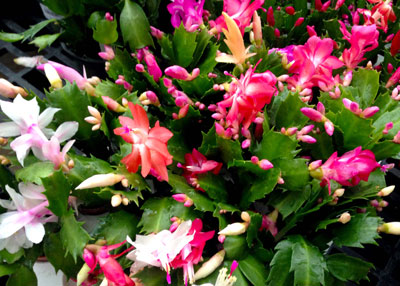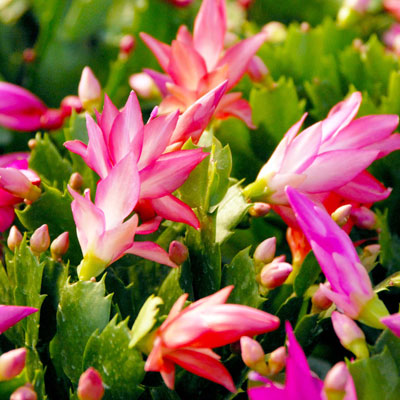Christmas Cacti Are Right on Time
If you visit the tropical jungles of South America, and if you look up high above your head, you’re likely to see Christmas cacti in riotous bloom. It’s their summertime, and they’re celebrating by flowering.

Photo: Terry Payne posted this photo of a handsome Christmas cactus on my Facebook page on December 6. You can see how the plant grows suspended in air. Well done, Terry!
But in a jungle? And up in trees? Cacti? Really?
While most members of the cactus family are terrestrial growers, Christmas cacti are epiphytes. That refers to the fact that they grow suspended from tree trunks and hanging from rocks. Pieces of stems and seeds fall into leaf axils of their support trees and cracks in the rocks. The plants develop roots, and stem growth begins. But even though it may rain 100 inches per year, these plants still have highly evolved ways of surviving without soil and during the dry seasons.

Photo: Grouping of Christmas cacti came into bloom about the same time and displayed the diversity in their flower colors.
What it takes to grow them at home…
When we grow Christmas cacti in our homes and greenhouses, we need to simulate those jungle conditions as closely as we can. They require highly organic, well-draining soils. Coarse-textured forms of organic matter such as sphagnum peat and finely ground pine bark mulch work well. What you don’t want is our heavy, sticky native soil or dense commercial potting soils.
Bright light is important, but not direct sunlight during the summer. Again, think of their native habitats. They grow within rainforest canopies. A sunny window indoors is good. That translates to bright shade outside.

Photo: Christmas cactus flowers are incredibly showy, whether viewed close-up or from a distance.
A trick you may not know about…
Christmas cacti are photoperiodic. That means that they measure the length of the dark period. The plant hormone that initiates flower bud formation is destroyed by light, so if Christmas cacti are exposed to bright light at night it will delay their blooming.
As with poinsettias, you’ll want to give them 14 hours of total and uninterrupted darkness each night beginning in early October. That will bring them into bloom by early December. But read that again carefully – darkness at night. They’ll still need their normal bright light during the daytime.
Starting more plants…
Want to start more plants? Each stem segment (those are stems, not leaves) is capable of forming roots.
• After the plant finishes blooming, carefully trim off pieces of stem with two or three segments.
• Lay them on a pot filled with the recommended planting mix.
• Keep the mix moist, and the segments will begin to form roots almost immediately.
• Once the roots are 1/2-inch long you can pot the cuttings up into the same planting mix, two or three cuttings per 4-inch pot.
And one of the coolest things about Christmas cacti is that they become family heirlooms that can be propagated and shared with all the family members that would like to have them. “Plants Grandma grew decades ago!”
